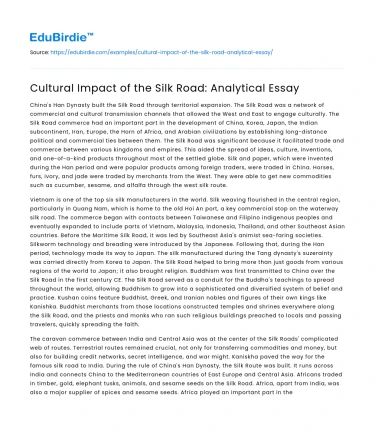China's Han Dynasty built the Silk Road through territorial expansion. The Silk Road was a network of commercial and cultural transmission channels that allowed the West and East to engage culturally. The Silk Road commerce had an important part in the development of China, Korea, Japan, the Indian subcontinent, Iran, Europe, the Horn of Africa, and Arabian civilizations by establishing long-distance political and commercial ties between them. The Silk Road was significant because it facilitated trade and commerce between various kingdoms and empires. This aided the spread of ideas, culture, inventions, and one-of-a-kind products throughout most of the settled globe. Silk and paper, which were invented during the Han period and were popular products among foreign traders, were traded in China. Horses, furs, ivory, and jade were traded by merchants from the West. They were able to get new commodities such as cucumber, sesame, and alfalfa through the west silk route.
Vietnam is one of the top six silk manufacturers in the world. Silk weaving flourished in the central region, particularly in Quang Nam, which is home to the old Hoi An port, a key commercial stop on the waterway silk road. The commerce began with contacts between Taiwanese and Filipino indigenous peoples and eventually expanded to include parts of Vietnam, Malaysia, Indonesia, Thailand, and other Southeast Asian countries. Before the Maritime Silk Road, it was led by Southeast Asia's animist sea-faring societies. Silkworm technology and breading were introduced by the Japanese. Following that, during the Han period, technology made its way to Japan. The silk manufactured during the Tang dynasty's suzerainty was carried directly from Korea to Japan. The Silk Road helped to bring more than just goods from various regions of the world to Japan; it also brought religion. Buddhism was first transmitted to China over the Silk Road in the first century CE. The Silk Road served as a conduit for the Buddha's teachings to spread throughout the world, allowing Buddhism to grow into a sophisticated and diversified system of belief and practice. Kushan coins feature Buddhist, Greek, and Iranian nobles and figures of their own kings like Kanishka. Buddhist merchants from those locations constructed temples and shrines everywhere along the Silk Road, and the priests and monks who ran such religious buildings preached to locals and passing travelers, quickly spreading the faith.
Save your time!
We can take care of your essay
- Proper editing and formatting
- Free revision, title page, and bibliography
- Flexible prices and money-back guarantee
The caravan commerce between India and Central Asia was at the center of the Silk Roads' complicated web of routes. Terrestrial routes remained crucial, not only for transferring commodities and money, but also for building credit networks, secret intelligence, and war might. Kaniskha paved the way for the famous silk road to India. During the rule of China's Han Dynasty, the Silk Route was built. It runs across India and connects China to the Mediterranean countries of East Europe and Central Asia. Africans traded in timber, gold, elephant tusks, animals, and sesame seeds on the Silk Road. Africa, apart from India, was also a major supplier of spices and sesame seeds. Africa played an important part in the Silk Road trade from antiquity through modern times when much of the Silk Road trade was supplanted by European corporate conglomerates like the Dutch and British East India Companies who created trade monopolies to move goods around the Old World instead. Enslaved persons were a tragically prevalent 'good trade ' along the Silk Road.' Captives would be taken by raiding armies and sold to private traffickers in far-flung ports and capitals from Dublin in the west to Shandong in the east.
Though silk was the most valuable commodity exported from China, many other items and ideas were traded, including religions (particularly Buddhism), syncretic philosophies, scientific discoveries, and technology such as paper and gunpowder. Although the Silk Road hasn't been utilized for international trade in nearly 600 years, the routes have had a lasting impact on economics, society, and history that continues to this day.






 Stuck on your essay?
Stuck on your essay?

